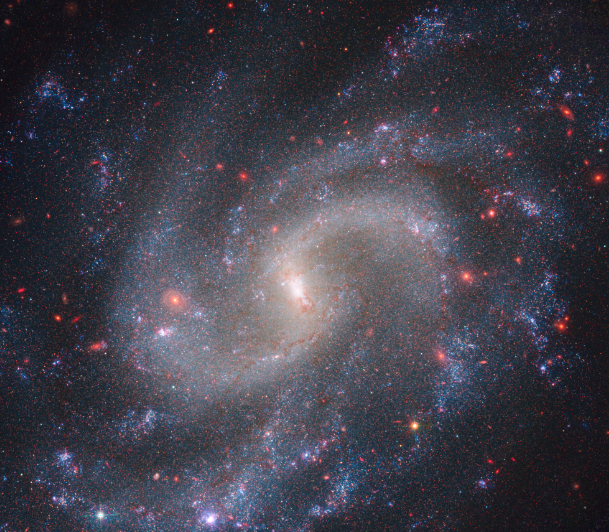NASA's James Webb Space Telescope is playing a pivotal role in addressing the perplexing cosmic problem called the "Hubble Tension." This enigma involves the variation between the Hubble Constant's value, which signifies the universe's expansion rate.
Nobel Laureate Adam Riess, affiliated with the Johns Hopkins University and the Space Telescope Science Institute, and his colleagues had publicly released their recent work.
Their research used James Webb Space Telescope's observations to enhance the precision of local measurements of the "Hubble Constant."

The Hubble Constant
The universe may appear unchanging, but all the things we see are actually moving away at a tremendous rate called the Hubble Constant.
The Hubble Constant is a fundamental parameter for unraveling the universe's history and ultimate fate, but measuring it returns different results.
One way to measure it is by looking at relics of the early universe, like remaining light in the cosmic microwave background or sound waves frozen in time.
The second method is by measuring the distances to objects with known intrinsic brightness, such as Cepheid variable stars. Astronomers employ Cepheid variable stars, known for their pulsating luminosity, which provides a basis for measuring their distances from Earth.
The duration of their pulsations indicates their intrinsic brightness, with more extended periods denoting greater luminosity. These supergiant stars, approximately a hundred thousand times brighter than the sun, serve as invaluable tools for gauging the distances of galaxies located millions or more light-years away.
However, a significant challenge arises when observing Cepheids within galaxies due to their proximity to other stars along our line of sight. The Hubble Space Telescope was conceived to mitigate this challenge, as its location above Earth's atmosphere minimizes optical distortions.
Hubble's advanced visible-wavelength resolution allows astronomers to identify individual Cepheids and track changes in their luminosity over time.
Nevertheless, Riess explained that a comprehensive understanding of these stars demands observations in the near-infrared spectrum to evade interference from interstellar dust. Dust primarily scatters and absorbs blue optical light, which can distort distance measurements.
Hubble's near-infrared capabilities are constrained compared to its blue light observations, often resulting in Cepheid starlight blending with nearby stars, introducing measurement noise.
In contrast, Webb excels in the near-infrared spectrum, effectively isolating Cepheid light from adjacent stars with minimal blending.
The initial step encompasses the examination of Cepheids in galaxies with known geometric distances, which calibrate the actual luminosity of these stars. The second step involves studying Cepheids in the host galaxies of recent Type Ia supernovae.
Webb's initial measurements from these steps enable the completion of the distance ladder, facilitating a comparison with Hubble's prior measurements.
Expanding Universe
The first method of measuring the Hubble Constant returns to an expansion rate of about 67 kilometers per second per megaparsec. The second is approximately 73 kilometers per second per megaparsec. According to Science Alert, the discrepancy between the two is known as the "Hubble Tension."
These findings have confirmed the accuracy of Hubble's earlier measurements. However, a disagreement between different measurement methods under the Hubble Tension reportedly remains intact.
"What the results still do not explain is why the universe appears to be expanding so fast! We can predict the expansion rate of the universe by observing its baby picture, the cosmic microwave background, and then employing our best model of how it grows up over time to tell us how fast the universe should be expanding today," Riess said.
"The fact that the present measure of the expansion rate significantly exceeds the prediction is a now decade-long problem called The Hubble Tension," he added.
Several possibilities exist to explain the Hubble Tension, ranging from the presence of exotic dark energy and dark matter to revisions in our understanding of gravity or the existence of unique cosmic elements.
While multiple measurement errors conspiring in the same direction could provide a more mundane explanation, Riess said the convergence of Webb's measurements with Hubble's lends stronger credence to more captivating explanations.
Webb's contribution reinforces the notion that systematic errors in Hubble's Cepheid measurements are not the primary contributors to the Hubble Tension, leaving the door open for more intriguing cosmic revelations. The universe's expansion remains a profound mystery, and Webb's capabilities are shedding new light on this enigma.
The findings of the team were recently published in arXiv.

![Apple Watch Series 10 [GPS 42mm]](https://d.techtimes.com/en/full/453899/apple-watch-series-10-gps-42mm.jpg?w=184&h=103&f=9fb3c2ea2db928c663d1d2eadbcb3e52)



